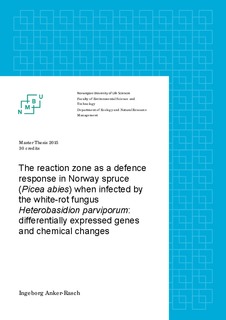The reaction zone as a defense response in Norway spruce (Picea abies) when infected by the white-rot fungus Heterobasidion parviporum : differentially expressed genes and chemical changes
Master thesis
Permanent lenke
http://hdl.handle.net/11250/295941Utgivelsesdato
2015-08-11Metadata
Vis full innførselSamlinger
- Master's theses (INA) [593]
Sammendrag
Heterobasidion parviporum (Fr.) is a pathogenic white-rot fungus that causes root and butt rot in Norway spruce (Picea abies (L.) Karsten), leading to tremendous economical losses in Norway and the rest of Europe. Knowledge of defense responses to infection of the pathogen will enable us to breed for more resistant plant material. We focused on the reaction zone in sapwood, which occurs as a defense response when sapwood is infected with the pathogen. Sapwood in 60- and 23 year old Norway spruce trees were treated with wounding or inoculation of H. parviporum or methyl jasmonate mimicking infection from the heartwood and inducing a reaction zone. Chemical and gene expression analysis was conducted on samples from experimental inductions of chemical reaction zone around the inoculation and wound in sapwood.
The stilbenes E-Astringin and iso-rhaphontin and one chlorogenic acid derivative were identified with HPLC analysis, and decreased in concentration upon pathogen inoculation and wounding in experiment 1 and 2, respectively. Several unidentified phenolic compounds (UPC) decreased upon either wounding or pathogen inoculation, or both. Gene expression was quantified using qRT PCR analysis, verifying an induction of genes connected to the phenylpropanoid pathway. In experiment 1, CCoAOMT1, CCoAOMT2, HCT, DAHP2, ANH2 and PAL2 were up regulated upon pathogen inoculation at different depths. MYB8 showed differences in expression between the inoculation depths. Wounding caused an up regulation of PAL2 and CCoAOMT1 in experiment 2, and down regulation of STS. PAL2 was up regulated upon methyl jasmonate inoculation.
The decrease of stilbenes can be linked to down regulation of STS. We hypothesize that this is a sign of a degradation of the stilbenes, which in turn may be converted to compounds with inhibitory effects on pathogen infection. As we did not detect any increase in any other compounds, we have no good explanation for the observed decreased concentration of chlorogenic acid derivatives. The up regulation of DAPH2 and ANH2 may be connected to the reallocation of carbon to the reaction zone, while the increased expression of PAL2 catalyzes the phenylpropanoid pathway, where HCT, CCoAOMT1 and CCoAOMT2 are involved. This indicates an increase in defense related genes upon infection or wounding in sapwood, and to some degree also by inoculation of methyl jasmonate.
